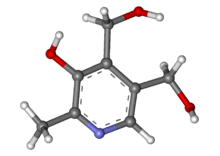Pyridoxine
 | |
 Pyridoxine | |
| Clinical data | |
|---|---|
| AHFS/Drugs.com | Monograph |
| Pregnancy category |
|
| Routes of administration | by mouth, IV, IM, subQ |
| ATC code | |
| Identifiers | |
| |
| Synonyms | vitamin B6,[1] pyridoxol[2] |
| CAS Number | |
| DrugBank | |
| ChemSpider | |
| UNII | |
| KEGG | |
| ChEBI | |
| ChEMBL | |
| ECHA InfoCard | 100.000.548 |
| Chemical and physical data | |
| Formula | C8H11NO3 |
| Molar mass | 169.18 g·mol−1 |
| 3D model (JSmol) | |
| Melting point | 159 to 162 °C (318 to 324 °F) |
| |
| |
Pyridoxine, also known as vitamin B6 and pyridoxol, is a form of vitamin B6 found commonly in food and used as dietary supplement.[1] As a supplement it is used to treat and prevent pyridoxine deficiency, sideroblastic anaemia, pyridoxine-dependent epilepsy, certain metabolic disorders, problems from isoniazid, and certain types of mushroom poisoning.[3][1] It is used by mouth or by injection.[3]
It is usually well tolerated. Occasionally side effects include headache, numbness, and sleepiness. Normal doses are safe during pregnancy and breastfeeding. Pyridoxine is in the vitamin B family of vitamins. It is required by the body to make amino acids, carbohydrates, and lipids.[3] Sources in the diet include fruit, vegetables, and grain.[4]
Pyridoxine was discovered in 1934, isolated in 1938, and first made in 1939.[5][6] It is on the World Health Organization's List of Essential Medicines, the most effective and safe medicines needed in a health system.[7] Pyridoxine is available as a generic medication and over the counter.[3] The wholesale cost in the developing world is about 0.59 to 3.54 USD per month.[8] Foods, such as breakfast cereal have pyridoxine added in some countries.[4]
References
- 1 2 3 WHO Model Formulary 2008 (PDF). World Health Organization. 2009. p. 496. ISBN 9789241547659. Retrieved 8 December 2016.
- ↑ Dryhurst, Glenn (2012). Electrochemistry of Biological Molecules. Elsevier. p. 562. ISBN 9780323144520.
- 1 2 3 4 "Pyridoxine Hydrochloride". The American Society of Health-System Pharmacists. Retrieved 8 December 2016.
- 1 2 "Office of Dietary Supplements - Dietary Supplement Fact Sheet: Vitamin B6". ods.od.nih.gov. 11 February 2016. Retrieved 30 December 2016.
- ↑ Squires, Victor R. (2011). The Role of Food, Agriculture, Forestry and Fisheries in Human Nutrition - Volume IV. EOLSS Publications. p. 121. ISBN 9781848261952.
- ↑ Harris, Harry (2012). Advances in Human Genetics 6. Springer Science & Business Media. p. 39. ISBN 9781461582649.
- ↑ "WHO Model List of Essential Medicines (19th List)" (PDF). World Health Organization. April 2015. Retrieved 8 December 2016.
- ↑ "Vitamin B6". International Drug Price Indicator Guide. Retrieved 8 December 2016.